class: center, middle, inverse, title-slide .title[ # Quantifying the shape of plants ] .subtitle[ ## using the Euler Characteristic Transform ] .author[ ### <strong>Erik Amézquita</strong>, Michelle Quigley, Tim Ophelders <br> Elizabeth Munch, Dan Chitwood <br> Dan Koenig, Jacob Landis <br> - ] .institute[ ### Computational Mathematics, Science and Engineering <br> Michigan State University <br> - ] .date[ ### 2024-03-14 <br> - <br> In <a href="https://doi.org/10.1093/insilicoplants/diab033"><em>inSilico Plants</em> <strong>4</strong>(1) 2022</a> ] --- background-image: url("../../img/endlessforms.png") background-size: 150px background-position: 89% 7% class: inverse # Plant morphology <div class="row"> <div class="column" style="max-width:50%"> <iframe width="375" height="210" src="https://www.youtube-nocookie.com/embed/oM9kAq0PBvw?controls=0" frameborder="0" allow="accelerometer; autoplay; encrypted-media; gyroscope; picture-in-picture" allowfullscreen></iframe> <iframe width="375" height="210" src="https://www.youtube-nocookie.com/embed/V39K58evWlU?controls=0" frameborder="0" allow="accelerometer; autoplay; encrypted-media; gyroscope; picture-in-picture" allowfullscreen></iframe> </div> <div class="column" style="max-width:50%"> <iframe width="375" height="210" src="https://www.youtube-nocookie.com/embed/4GBgPIEDoa0?controls=0" frameborder="0" allow="accelerometer; autoplay; encrypted-media; gyroscope; picture-in-picture" allowfullscreen></iframe> <iframe width="375" height="210" src="https://www.youtube-nocookie.com/embed/qkOjHHuoUhA?controls=0" frameborder="0" allow="accelerometer; autoplay; encrypted-media; gyroscope; picture-in-picture" allowfullscreen></iframe> </div> </div> <p style="font-size: 24px; text-align: right; font-family: 'Yanone Kaffeesatz'">Check out more 3D X-ray CT scans at <a href="https://www.youtube.com/@endlessforms6756">youtube.com/@endlessforms6756</a></p> --- # Traditional Morphometry <img src="https://nph.onlinelibrary.wiley.com/cms/asset/e0e8b362-efee-410a-a293-947c2d57acb9/nph16286-fig-0003-m.jpg" width="650" style="display: block; margin: auto;" /> <p style="font-size: 10px; text-align: right; color: Grey;"> Credits: <a href=" https://doi.org/10.1111/nph.16286">Gupta <em>et al.</em> (2019)</a></p> --- # Modern Morphometric Methods might not be enough .pull-left[ Elliptical Fourier Descriptor (EFD) 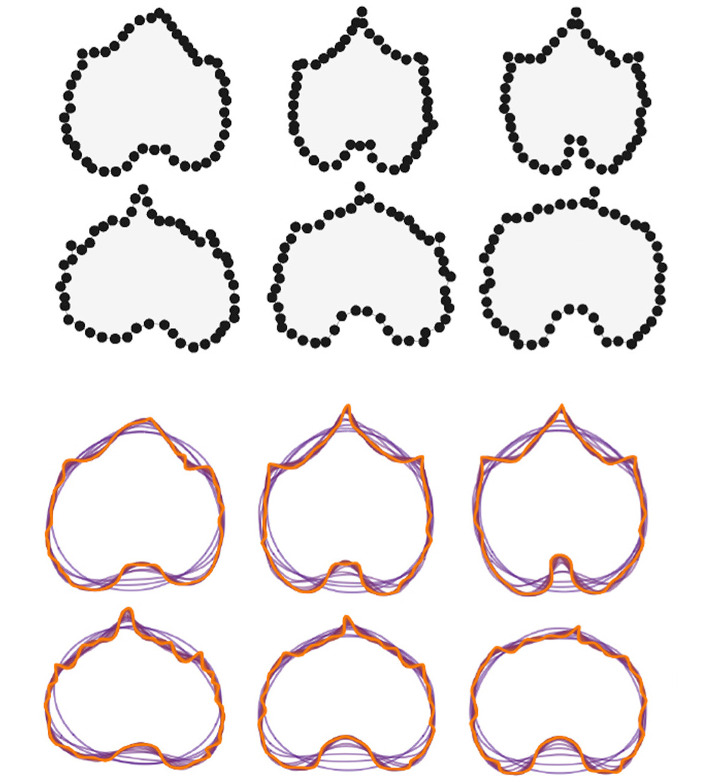 <p style="font-size: 10px; text-align: right; color: Grey;"> Credits: <a href="https://doi.org/10.1016/j.cub.2016.02.033">Chitwood and Sinha (2016)</a></p> ] .pull-right[ Landmark-based morphometrics (GMM) 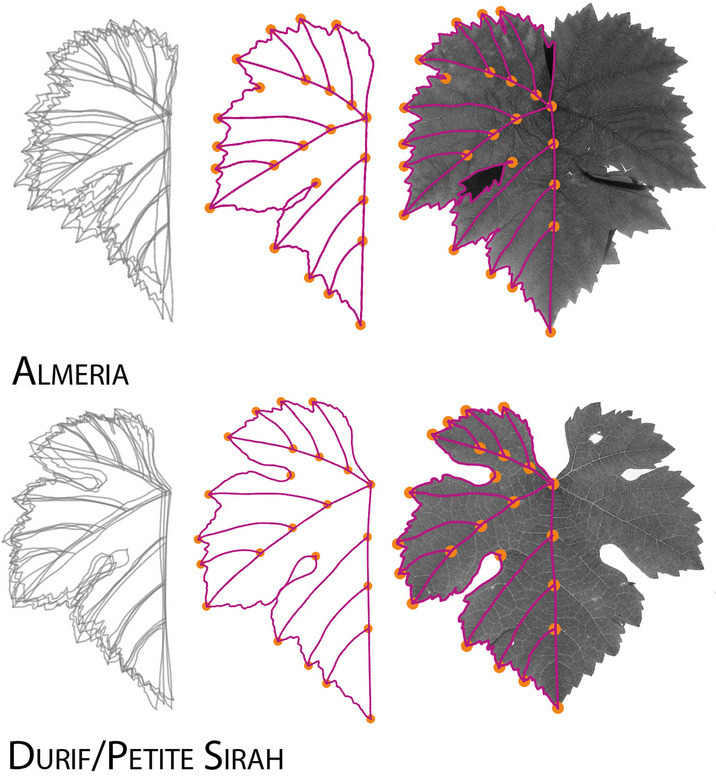 <p style="font-size: 10px; text-align: right; color: Grey;"> Credits: <a href=" https://doi.org/10.1002/ppp3.10157">Chitwood (2020)</a></p> ] --- background-image: url("../../img/endlessforms.png") background-size: 150px background-position: 89% 7% class: inverse # Something more robust is needed <div class="row"> <div class="column" style="max-width:50%"> <iframe width="375" height="210" src="https://www.youtube-nocookie.com/embed/j0R9mMs5E50?controls=0" title="YouTube video player" frameborder="0" allow="accelerometer; autoplay; clipboard-write; encrypted-media; gyroscope; picture-in-picture" allowfullscreen></iframe> <iframe width="375" height="210" src="https://www.youtube-nocookie.com/embed/2FmwkEA3tsY?controls=0" title="YouTube video player" frameborder="0" allow="accelerometer; autoplay; clipboard-write; encrypted-media; gyroscope; picture-in-picture" allowfullscreen></iframe> </div> <div class="column" style="max-width:50%"> <iframe width="375" height="210" src="https://www.youtube-nocookie.com/embed/vxcSZsCs5BU?controls=0" title="YouTube video player" frameborder="0" allow="accelerometer; autoplay; clipboard-write; encrypted-media; gyroscope; picture-in-picture" allowfullscreen></iframe> <iframe width="375" height="210" src="https://www.youtube-nocookie.com/embed/KXt-C-_OA3o?controls=0" title="YouTube video player" frameborder="0" allow="accelerometer; autoplay; clipboard-write; encrypted-media; gyroscope; picture-in-picture" allowfullscreen></iframe> </div> </div> <p style="font-size: 24px; text-align: right; font-family: 'Yanone Kaffeesatz'">Check out more 3D X-ray CT scans at <a href="https://www.youtube.com/@endlessforms6756">youtube.com/@endlessforms6756</a></p> --- # Topological Data Analysis (TDA) <div class="row"> <div class="column" style="max-width:25%; font-size: 15px;"> <img style="padding: 25px 0 35px 0;" src="../figs/S019_L0_1.gif"> <p style="font-size: 25px; text-align: center; color: DarkRed;"> Raw Data </p> <ul> <li> X-ray CT </li> <li> Point clouds </li> <li> Time series </li> <ul> </div> <div class="column" style="max-width:40%; padding: 0 25px 0 25px; font-size: 15px;"> <img src="../figs/ecc_X.gif"> <p style="font-size: 23px; text-align: center; color: DarkRed;"> Topological Summary </p> <ul> <li> Euler Characteristic </li> <li> Persistence diagrams </li> <li> Mapper/Reeb graphs </li> <ul> </div> <div class="column" style="max-width:35%; font-size: 15px;"> <img src="../figs/svm_mds_ect.gif"> <p style="font-size: 25px; text-align: center; color: DarkRed;"> Analysis </p> <ul> <li> Statistics </li> <li> Machine learning </li> <li> Classification/prediction </li> <ul> </div> </div> --- background-image: url("../figs/seed.png") background-size: 325px background-position: 99% 99% # Roadmap for today ### Split into modules 1. Survey of TDA in biology applications 1. The Euler Characteristic Transform 1. Quantifying barley morphology using TDA 1. Current work on modeling citrus (with TDA in the horizon) --- class: inverse, middle, center # 1. TDA meets biology in a number of ways ## Quick TDA recap ## The significance of detecting connected components and holes --- # 1st TDA Ingredient: Complexes - Think the data as a collection of elementary building blocks ( _cells_ ) Vertices | Edges | Faces | Cubes ---------|-------|-------|------- 0-dim | 1-dim | 2-dim | 3-dim - A collection of cells is a _cubical complex_ - Count the number of topological features ( _holes_ ): Connected components | Loops | Voids ---------------------|-------|------- 0-dim | 1-dim | 2-dim - Example with 2 connected components, 1 loop, 0 voids <img src="../../tda/figs/binary_to_cubical_complex_textless.svg" width="500" style="display: block; margin: auto;" /> --- # 2nd TDA Ingredient: Filters - Each cell is assigned a real value which defines how the complex is constructed. - Observe how the number of topological features change as the complex grows. .pull-left[ <img src="../figs/eigcurv_filter.gif" width="250px" style="display: block; margin: auto;" /><img src="../figs/gaussian_density_filter.gif" width="250px" style="display: block; margin: auto;" /> ] .pull-right[ <img src="../figs/eccentricity_filter.gif" width="250px" style="display: block; margin: auto;" /><img src="../figs/vrips_ver2.gif" width="250px" style="display: block; margin: auto;" /> ] --- ## Example 1 ### Detecting holes → detect cancerous tissue .pull-left[  ] .pull-right[  ] <p style="font-size: 10px; text-align: right; color: Grey;"> Credits: <a href="https://doi.org/10.1016/j.media.2019.03.014">Qaiser <em>et al.</em> (2019)</a></p> --- ## Example 2 ### Detect holes → detect reassortment and horizontal evolution .pull-left[  ] .pull-right[  ] <p style="font-size: 10px; text-align: right; color: Grey;"> Credits: <a href="https://doi.org/10.1073/pnas.1313480110">Chan <em>et al.</em> (2013)</a></p> --- ## Example 3 ### Detect holes → detect open and closed conformations .pull-left[   ] .pull-right[  ] <p style="font-size: 10px; text-align: right; color: Grey;"> Credits: <a href="https://doi.org/10.1515/sagmb-2015-0057">Kovacev-Nikolic <em>et al.</em> (2016)</a></p> --- ## Example 4 ### Detect connected components across slices → detect panicle structure <img src="https://media.springernature.com/original/springer-static/image/chp%3A10.1007%2F978-3-030-20867-7_7/MediaObjects/484957_1_En_7_Fig1_HTML.png" width="375" style="display: block; margin: auto;" /> <p style="font-size: 10px; text-align: right; color: Grey;"> Credits: <a href="https://doi.org/10.1007/978-3-030-20867-7_7">Chitwood <em>et al.</em> (2019)</a></p> --- ## Example 5 ### Detect componets across the morphospace → detect leaf development <img src="../../tda/figs/g86.png" width="450" style="display: block; margin: auto;" /> <p style="font-size: 10px; text-align: right; color: Grey;"> Credits: Percival <em>et al.</em> (in preparation)</p> --- # Advertisement - More content, references, and examples > Amézquita _et al._ (2020) "The shape of things to come: Topological data analysis and biology, from molecules to organisms". _Developmental Dynamics_ **249**(7) pp. 816-833. DOI: [10.1002/dvdy.175](https://doi.org/10.1002/dvdy.175)  --- class: inverse, middle, center # 2. Foucusing on the Euler Characteristic ## The Euler Characteristic Transform (ECT) --- # Topology: The Euler characteristic `\(\chi\)` `$$\chi = \#(\text{Vertices}) - \#(\text{Edges}) + \#(\text{Faces}).$$` <img src="../../tda/figs/euler_characteristic_2.png" width="400" style="display: block; margin: auto;" /> -- - Summarize **topological features** with the Euler-Poincaré formula `$$\chi = \#(\text{Connected Components}) - \#(\text{Loops}) + \#(\text{Voids}).$$` - The Euler characteristic is a **topological invariant**. --- background-image: url("../figs/ecc_ver2.gif") background-size: 750px background-position: 50% 90% # Euler Characteristic Curve (ECC) - Consider a cubical complex `\(X\subset\mathbb{R}^d\)` - And a unit-length direction `\(\nu\in S^{d-1}\)` - And the subcomplex containing all cubical cells below height `\(h\)` in the direction `\(\nu\)` `$$X(\nu)_h =\{\Delta \in X\::\:\langle x,\nu\rangle\leq h\text{ for all }x\in\Delta\}$$` - The Euler Characteristic Curve (ECC) of direction `\(\nu\)` is defined as the sequence `$$\{\chi(X(\nu)_h)\}_{h\in\mathbb{R}}$$` --- background-image: url("../figs/ect_ver2.gif") background-size: 800px background-position: 50% 88% ## Euler Characteristic Transform (ECT) - Repeat and concatenate for all possible directions. $$ `\begin{split} ECT(X):\; & S^{d-1} \to \mathbb{Z}^{\mathbb{R}}\\ &\nu\mapsto\{\chi(X(\nu)_h)\}_{h\in\mathbb{R}}. \end{split}` $$ - [**Theorem** (Turner, Mukherjee, Boyer 2014) & (Curry, Mukherjee, Turner, 2018)](http://arxiv.org/abs/1805.09782): The ECT is injective with a finite bound of necessary directions. --- # More on the ECT - Easy to compute: a quick alternating sum. [**Theorem _(Turner, Mukherjee, Boyer 2014)_**](https://doi.org/10.1093/imaiai/iau011): The ECT is injective for finite simplicial complexes in 3D. [**Theorem _(ibid)_**](https://arxiv.org/abs/1310.1030): The ECT is a sufficient statistic for finite simplicial complexes in 3D. *Translation:* - Given all the (infinite) ECCs corresponding to all possible directions, - *Different* simplicial complexes correspond to *different* ECTs. - The ECT effectively summarizes all possible information related to shape. There is elusive math research on computationally efficient reconstruction algorithms: - [Turner, Mukherjee, Curry (2021)](https://arxiv.org/abs/1805.09782): Finite no. of directions - [Betthauser (2018)](https://people.clas.ufl.edu/peterbubenik/files/Betthauser_Thesis.pdf): 2D reconstruction - [Fasy, Micka, Millman, Schenfisch, Williams (2022)](https://arxiv.org/abs/1912.12759): 3D reconstruction Alternative takes: - [Crawford, Monod, Chen, Mukherjee, Rabadan (2020)](https://doi.org/10.1080/01621459.2019.1671198): Smooth ECT - [Jiang, Kurtek, Needham (2020)](https://openaccess.thecvf.com/content_CVPRW_2020/papers/w50/Jiang_The_Weighted_Euler_Curve_Transform_for_Shape_and_Image_Analysis_CVPRW_2020_paper.pdf): Weighted ECT --- # Injectivity proof outline <embed src="../../tda/slides/lab200330.pdf" width="775px" height="475px" style="display: block; margin: auto;" type="application/pdf" /> --- class: inverse, middle, center # 3. Quantifying barley morphology ## Using the Euler Characteristic Transform --- class: inverse <div class="row"> <div class="column" style="max-width:44%"> <a href="https://kizilvest.ru/20150827-v-kizilskom-rajone-nachalas-uborochnaya-strada/" target="_blank"><img style="padding: 0 0 0 0;" src="../figs/barley_kizilskoye.jpg"></a> <a href="https://ipad.fas.usda.gov/highlights/2008/11/eth_25nov2008/" target="_blank"><img style="padding: 0 0 0 0;" src="../figs/barley_ethiopia.gif"></a> <a href="https://www.doi.org/10.1007/978-1-4419-0465-2_2168" target="_blank"><img style="padding: 0 0 0 0;" src="../figs/barley_historical_expansion.jpg"></a> </div> <div class="column" style="max-width:44%"> <a href="https://www.resilience.org/stories/2020-03-09/the-last-crop-before-the-desert/" target="_blank"><img style="padding: 0 0 0 0;" src="../figs/barley_morocco.jpg"></a> <a href="https://www.tibettravel.org/tibetan-culture/highland-barley.html" target="_blank"><img style="padding: 0 0 0 0;" src="../figs/barley_seed_tibet.jpg"></a> <a href="https://www.nationalgeographic.co.uk/travel/2020/05/photo-story-from-barley-fields-to-whisky-barrels-in-rural-scotland" target="_blank"><img style="padding: 0 0 0 0;" src="../figs/barley_seed_scotland_cropped.jpg"></a> </div> <div class="column" style="max-width:8%; font-size: 15px;"> <p style="text-align: center; font-size: 30px; line-height: 1em;"> <strong> Barley across the world </strong></p> <p>Kiliskoye (Chelyabinsk, Russia)</p> <p>Marchouch (Rabat, Morocco)</p> <p>Aksum (Tigray, Ethiopia)</p> <p>Salar (Tsetang, Tibet)</p> <p>Expansion of the barley. </p> <p>Turriff (Aberdeenshire, Scotland)</p> <p style="font-size:9px;line-height: 1em;">Click on any picture for more details and credits</p> </div> </div> --- background-image: url("../figs/composite_cross_v_02.svg") background-size: 425px background-position: 95% 90% # Cross Composite II experiment .pull-left[ 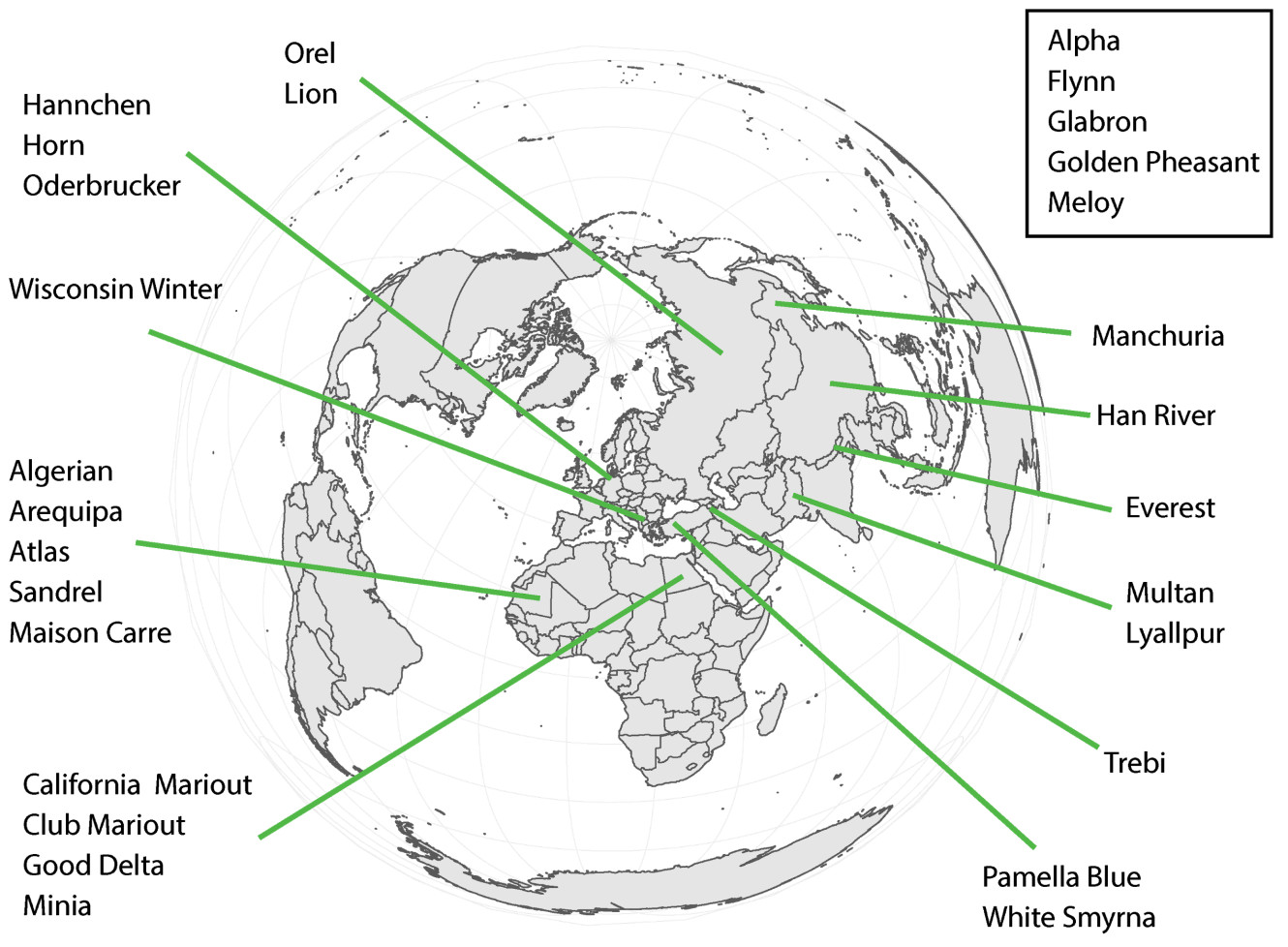 - **28 parents/accessions** `\((F_0)\)` - Do `\({28 \choose 2}\)` **hybrids** `\((F_1)\)` ] .pull-right[  ] --- background-image: url("../figs/composite_cross_v_05.svg") background-size: 425px background-position: 95% 90% # Cross Composite II experiment .pull-left[  - **28 parents/accessions** `\((F_0)\)` - Do `\({28 \choose 2}\)` **hybrids** `\((F_1)\)` - **Self-fertilize** the resulting 379 hybrids - Each line grows in a different part of an open field **for 58 generations** ] .pull-right[  ] --- # Raw Data: X-rays → Image Processing <div class="row"> <div class="column" style="max-width:51%; color: Navy; font-size: 15px;"> <img style="padding: 2px 0 2px 0;" src="../figs/x3000_setup.jpg"> <p style="text-align: center;"> Proprietary X-Ray CT scan reconstruction </p> </div> <div class="column" style="max-width:17.5%; color: Navy; font-size: 15px;"> <img src="../figs/S019_L0_1.gif"> <p style="text-align: center;"> 975 spikes </p> </div> <div class="column" style="max-width:20.5%; color: Navy; font-size: 15px;"> <img src="../figs/S017_L0_seed_10_0.gif"> <p style="text-align: center;"> 38,000 seeds </p> </div> </div> <div class="row"> <div class="column" style="max-width:35%; color: Navy; font-size: 15px;"> <img style="padding: 2px 0 2px 0;" src="../figs/seed_orientation1.png"> <p style="text-align: center;"> Align all the seeds </p> </div> <div class="column" style="max-width:55%; color: Navy; font-size: 15px;"> <div class="row"> <div class="column" style="max-width:24%; color: Navy; font-size: 15px;"> <img style="padding: 2px 0 2px 0;" src="../figs/seed_outlier1.png"> </div> <div class="column" style="max-width:24%; color: Navy; font-size: 15px;"> <img style="padding: 2px 0 2px 0;" src="../figs/seed_outlier2.png"> </div> <div class="column" style="max-width:24%; color: Navy; font-size: 15px;"> <img style="padding: 2px 0 2px 0;" src="../figs/seed_outlier3.png"> </div> <div class="column" style="max-width:24%; color: Navy; font-size: 15px;"> <img style="padding: 2px 0 2px 0;" src="../figs/seed_outlier4.png"> </div> </div> <p style="text-align: center;"> Remove outliers </p> </div> </div> --- # Traditional shape descriptors <div class="row"> <div class="column" style="max-width:55%"> <img style="padding: 0 0 0 0;" src="../figs/boxplot_founders_Length.png"> <img style="padding: 0 0 0 0;" src="../figs/boxplot_founders_Area.png"> </div> <div class="column" style="max-width:45%"> <img style="padding: 0 0 0 0;" src="../figs/boxplot_all_vol_h.png"> <img style="padding: 0 0 0 0;" src="../figs/boxplot_all_length_h.png"> <img style="padding: 0 0 0 0;" src="../figs/boxplot_all_area_h.png"> </div> </div> --- background-image: url("../figs/ect_ver2.gif") background-size: 600px background-position: 50% 98% # Topological shape descriptors .pull-left[ <img src="../figs/pole_directions_p7_m12_crop.jpg" width="250" style="display: block; margin: auto;" /> ] .pull-right[ - 158 directions - 16 slices per direction - Every seed is associated a `\(158\times16=2528\)`-dim vector - Reduced to 12 dimensions with UMAP ] --- # Supervised Learning 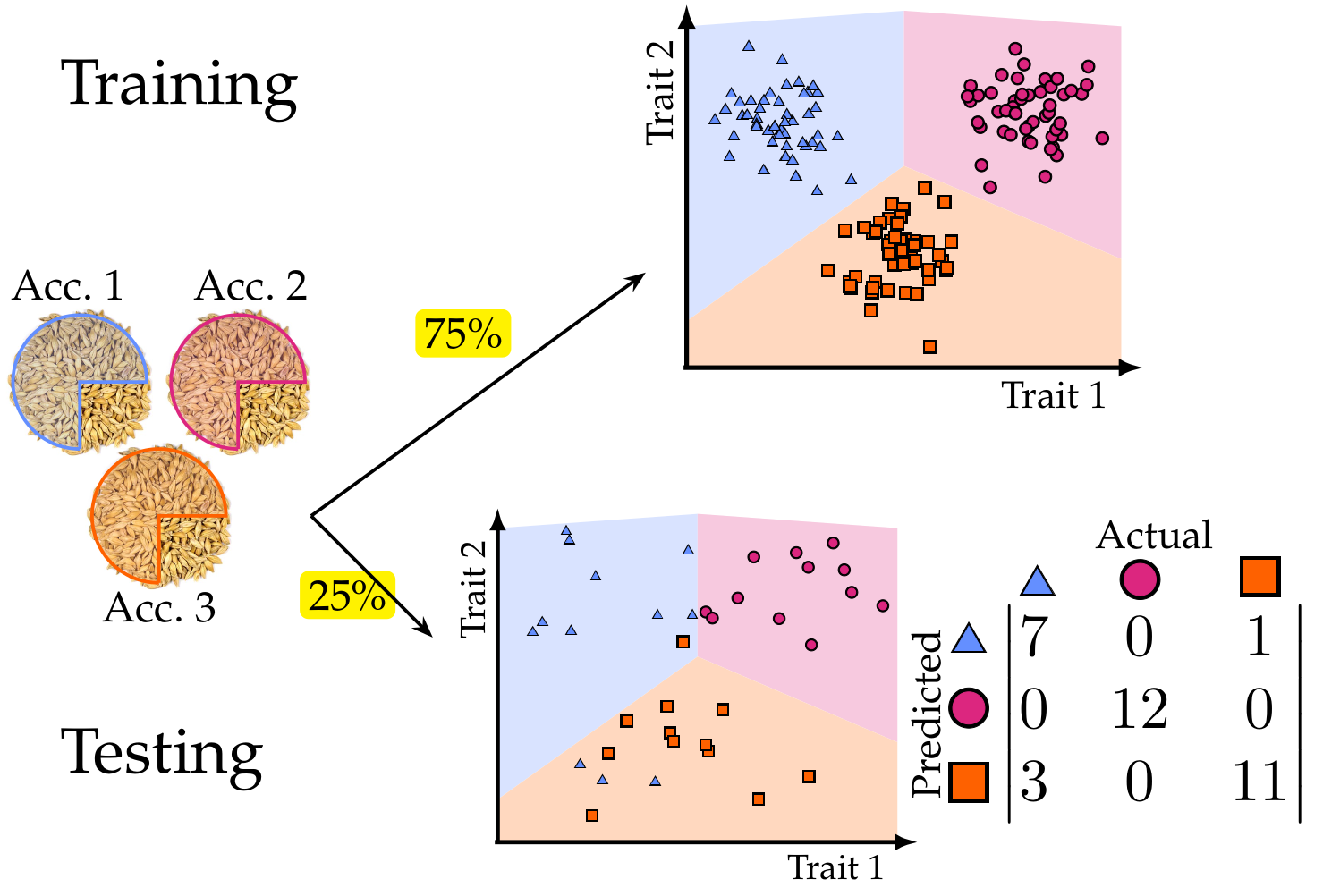 --- # Classification of 28 lines with SVM <style type="text/css"> .tg {border-collapse:collapse;border-color:#93a1a1;border-spacing:0;margin:0px auto;} .tg td{background-color:#fdf6e3;border-bottom-width:1px;border-color:#93a1a1;border-style:solid;border-top-width:1px; border-width:0px;color:#002b36;font-family:Arial, sans-serif;font-size:14px;overflow:hidden;padding:10px 5px; word-break:normal;} .tg th{background-color:#657b83;border-bottom-width:1px;border-color:#93a1a1;border-style:solid;border-top-width:1px; border-width:0px;color:#fdf6e3;font-family:Arial, sans-serif;font-size:14px;font-weight:normal;overflow:hidden; padding:10px 5px;word-break:normal;} .tg .tg-2bhk{background-color:#eee8d5;border-color:inherit;text-align:left;vertical-align:top} .tg .tg-0pky{border-color:inherit;text-align:left;vertical-align:top} .tg .tg-gyvr{background-color:#eee8d5;border-color:inherit;font-size:100%;text-align:left;vertical-align:top} </style> <table class="tg"> <thead> <tr> <th class="tg-0pky">Shape descriptors</th> <th class="tg-0pky">No. of descriptors</th> <th class="tg-0pky">F1</th> </tr> </thead> <tbody> <tr> <td class="tg-2bhk">Traditional</td> <td class="tg-2bhk">11</td> <td class="tg-2bhk">0.55 ± 0.019</td> </tr> <tr> <td class="tg-0pky">Topological + UMAP</td> <td class="tg-0pky">12</td> <td class="tg-0pky">0.74 ± 0.016</td> </tr> <tr> <td class="tg-2bhk">Combined</td> <td class="tg-2bhk">23</td> <td class="tg-2bhk">0.86 ± 0.010</td> </tr> </tbody> </table> <img src="../figs/avg_f1_combined_158_16_12_umap_horz.png" width="700" style="display: block; margin: auto;" /> --- # Traditional shape descriptors 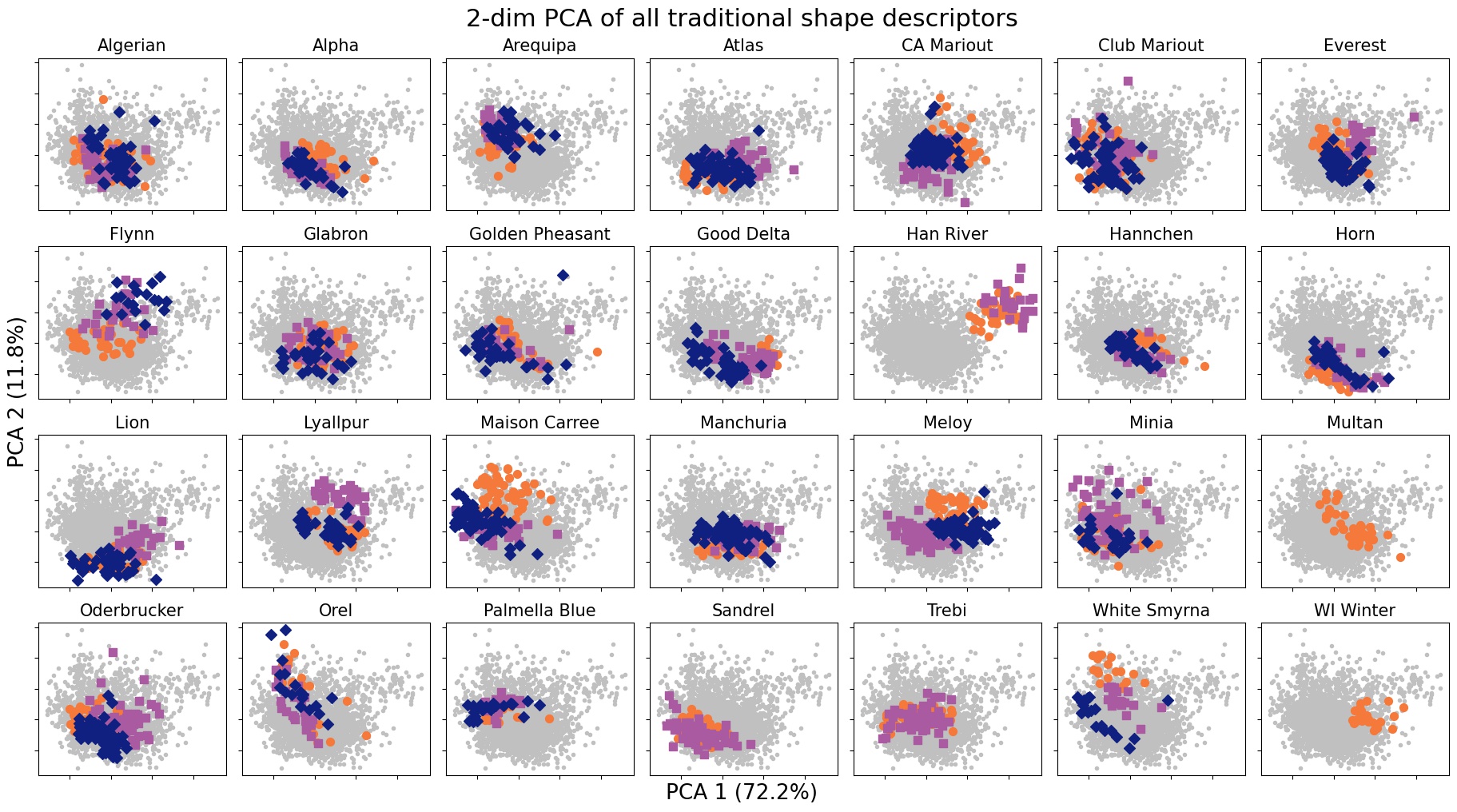 --- # Topological shape descriptors + UMAP 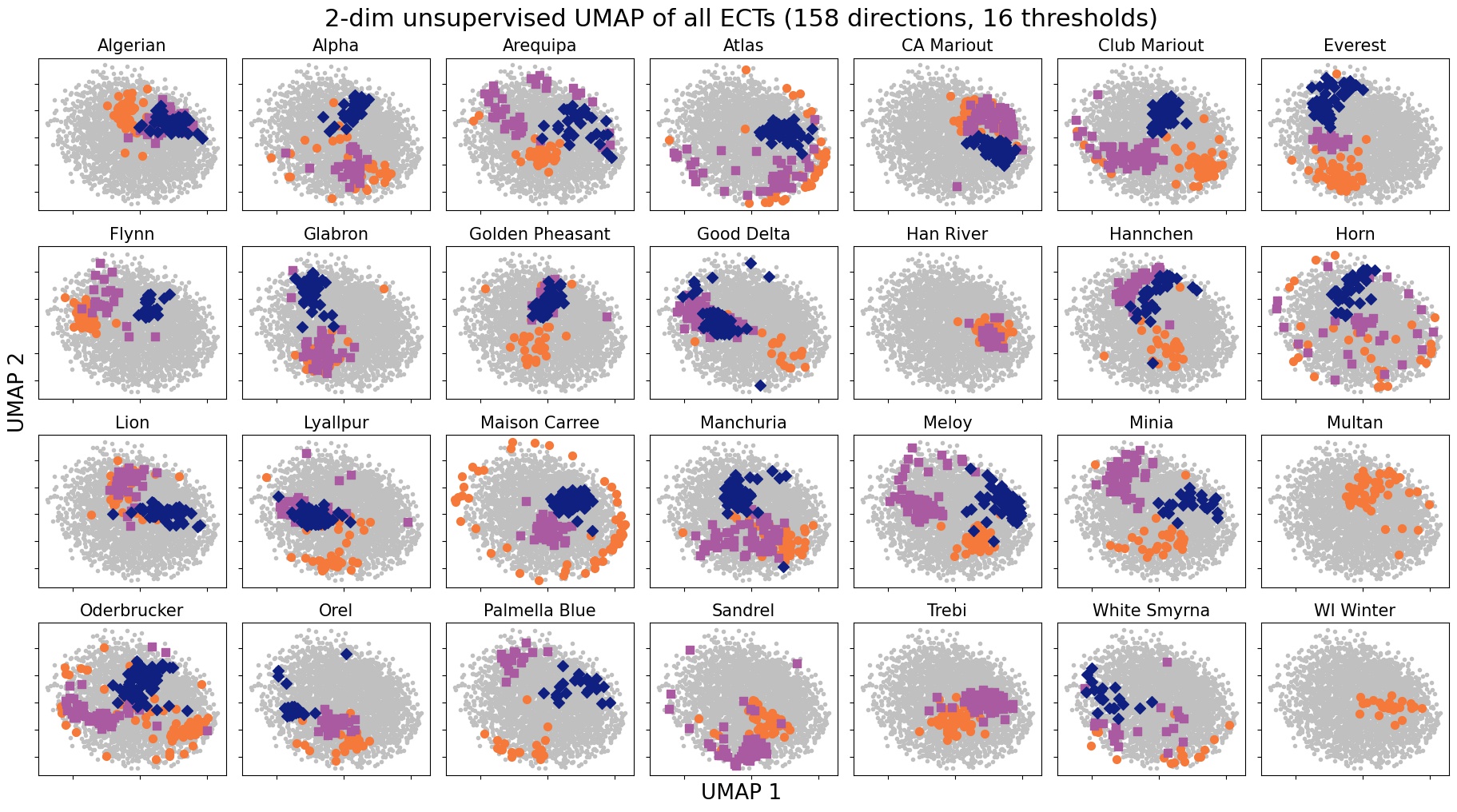 --- # Topological shape descriptors + KPCA 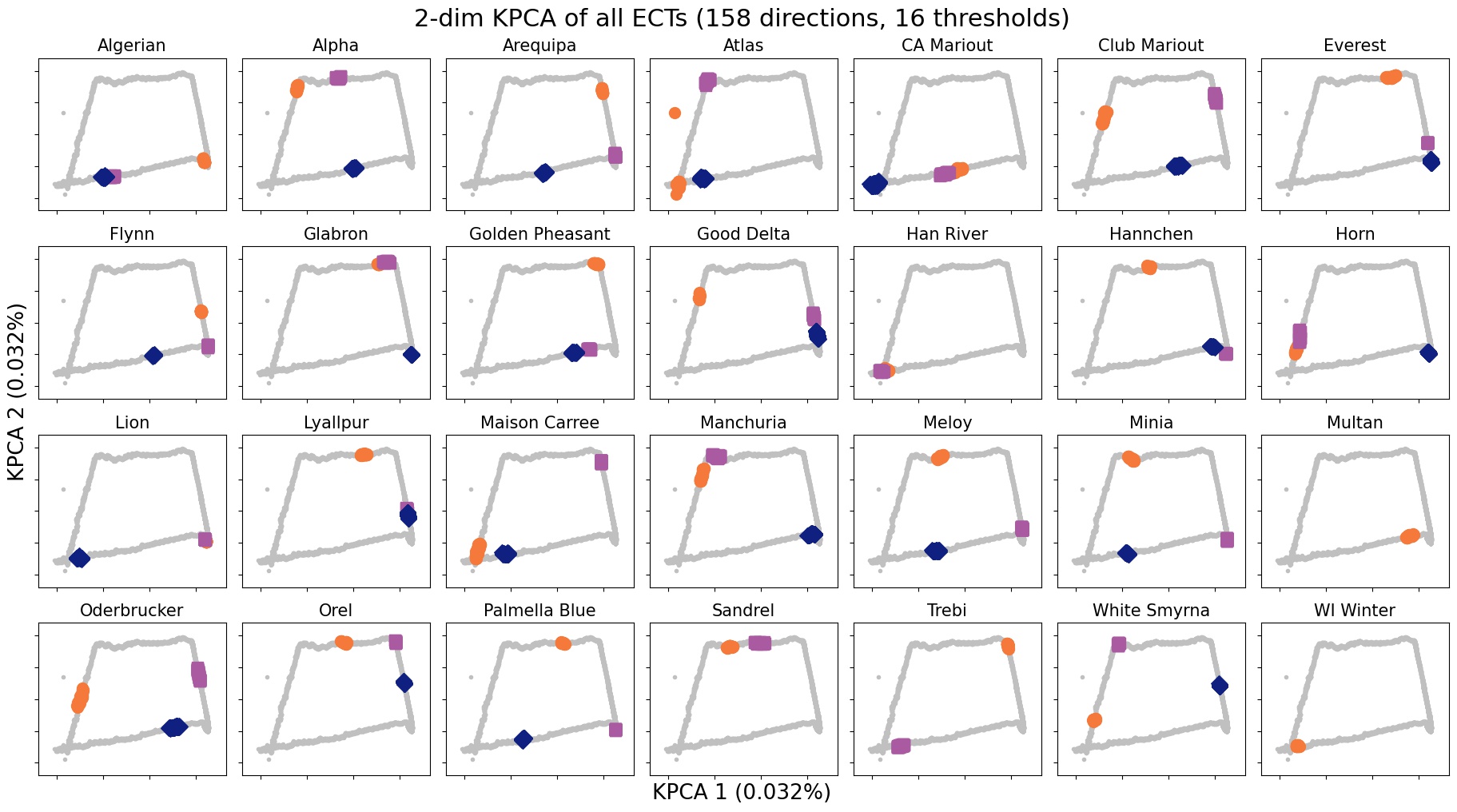 --- # Hidden topological shape information .pull-left[ - Analysis of variance to determine the most discerning directions and slices/thresholds. - The top crease on the seed is highly descriptive! <img src="../figs/kruskal_wallis_topo_summary.jpg" width="300" style="display: block; margin: auto;" /> ] -- .pull-right[ <img src="../figs/discerning_directions.png" width="225" style="display: block; margin: auto;" /> 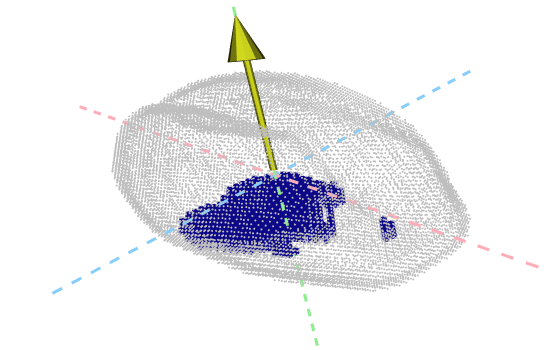 ] --- # Predicting with Semi-Supervised Learning 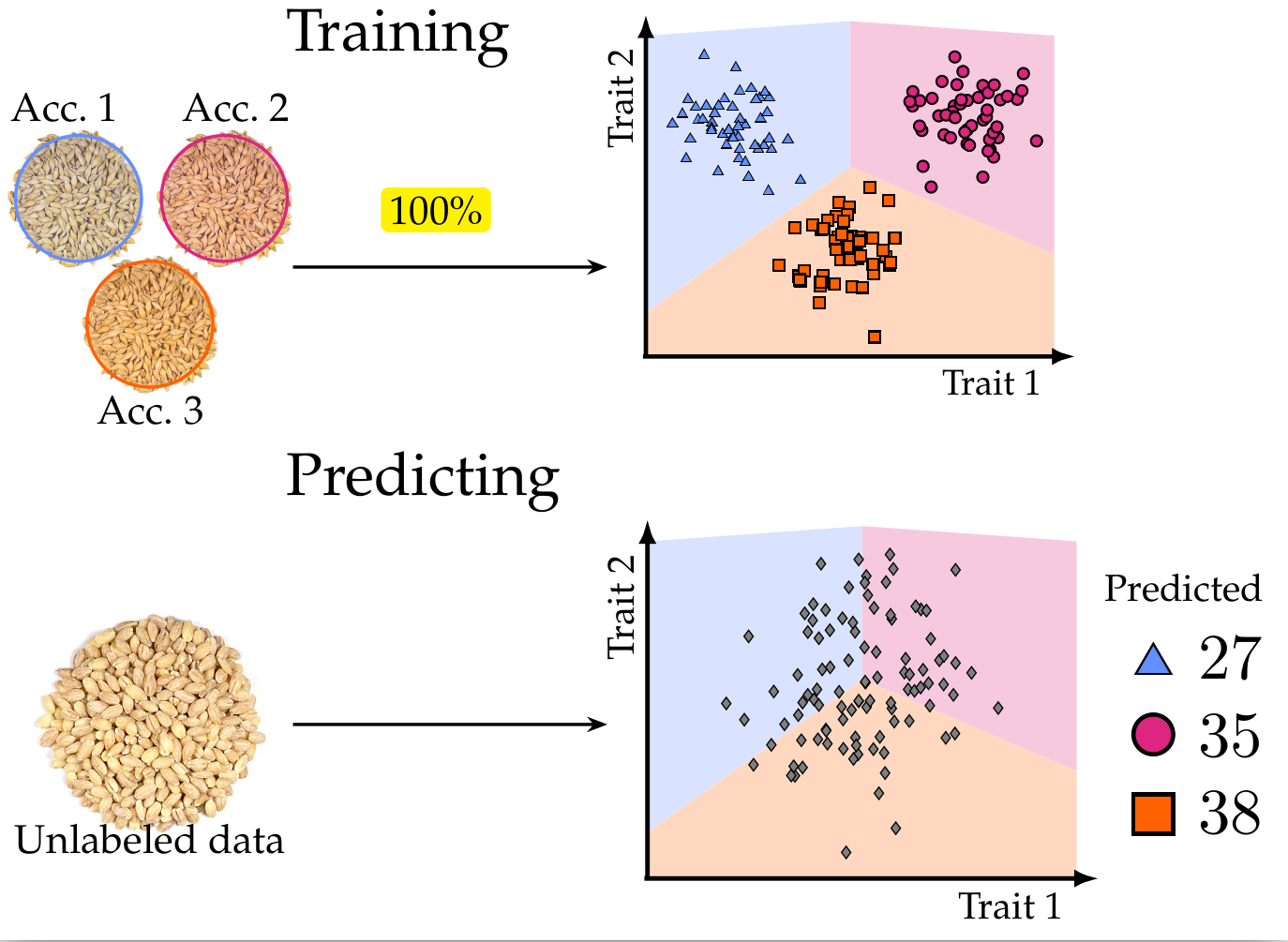 --- # Prediction into semi-supervised territory - Train an SVM with 100% of the founders `\((F_0)\)` - Classify the progeny `\((F_{18}\text{ and }F_{58})\)` to detect genotype enrichment .pull-left[  ] .pull-right[  ] --- background-image: url("../figs/comparison_lines_combined_topounscaled_d158_T16_horz.png") background-size: 900px background-position: 50% 70% ## Observe shape distribution across lines --- # Future directions .left-column[ 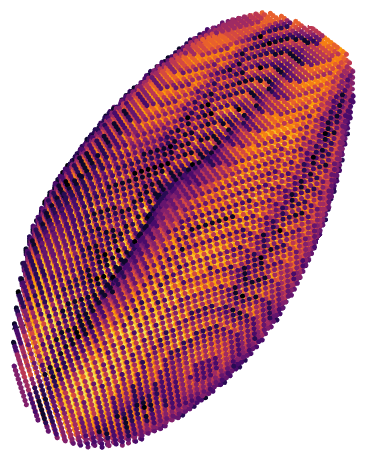 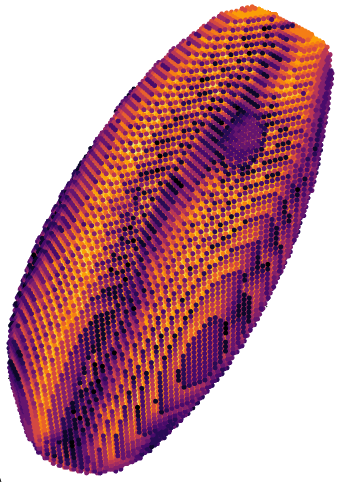 ] .right-column[ - Identify specific molecular markers corresponding to morphological differences across the diverse barley population. - Develop a high-throughput pipeline to produce 3D images of individual barley seeds and quantify comprehensively their morphology. - Formalize a method for promising seedling selection to further crop breeeding. - Extend such pipeline and population genetics studies to other crops and grains. ] --- background-image: url("../../img/phd_institutional_logos.jpg") background-size: 500px background-position: 95% 1% class: inverse ## Thank you! <div class="row" style="margin-top: -25px;"> <div class="column" style="max-width:19.5%; font-size: 13px;"> <img style="padding: 0 0 0 0;" src="https://i1.rgstatic.net/ii/profile.image/607374528233472-1521820780707_Q128/Elizabeth-Munch.jpg"> <p style="text-align: center; color: White">Liz Munch<br>(MSU)</p> <img style="padding: 0 0 0 0;" src="https://alga.win.tue.nl/images/staff/tim.jpg"> <p style="text-align: center; color: White">Tim Ophelders<br>(Utrecht)</p> </div> <div class="column" style="max-width:19.5%; font-size: 13px;"> <img style="padding: 0 0 0 0;" src="https://www.canr.msu.edu/contentAsset/image/9ae9777d-157c-46e6-9f12-d062ad35671e/fileAsset/filter/Jpeg,Resize,Crop/jpeg_q/80/resize_w/400/crop_x/0/crop_y/45/crop_w/400/crop_h/400"> <p style="text-align: center; color: White">Dan Chitwood<br>(MSU)</p> <img style="padding: 0 0 0 0;" src="https://i1.rgstatic.net/ii/profile.image/926632407748609-1597937790454_Q128/Michelle-Quigley.jpg"> <p style="text-align: center; color: White">Michelle Quigley<br>(PSU)</p> </div> <div class="column" style="max-width:16.5%; font-size: 13px;"> <img style="padding: 0 0 0 0;" src="https://plantbiology.ucr.edu/sites/g/files/rcwecm1001/files/styles/scale_225/public/Koenig.jpg?itok=P92Ow61p"> <p style="text-align: center; color: White">Dan Koenig<br>(UC Riverside)</p> <img style="padding: 0 0 0 0;" src="https://publons.com/media/thumbs/academic/photos/252a7116-ee14-4a5e-b44c-7c62ac11e217.png.200x200_q95_crop_detail_upscale.png"> <p style="text-align: center; color: White">Jacob Landis<br>(Cornell)</p> </div> <div class="column" style="width:3%; font-size: 24px;"> </div> <div class="column" style="max-width:40%; font-size: 24px; line-height:1.25"> <p style="text-align: center; color: White"><strong>Email</strong></p> <p style="text-align: center; color: Yellow">eah4d@missouri.edu</p> <p style="text-align: center; color: White"><strong>Slides and Website</strong></p> <p style="text-align: center; color: Yellow">ejamezquita.github.io</p> <p style="text-align: center; color: White"><strong>References</strong></p> <img style="padding: 0 0 0 0;" src="../figs/amezquita_etal_2021.png"> <p style="text-align: center; color: White; font-size:15px; line-height:1.1">Amézquita et al (2021) <em>in silico Plants</em><br>DOI: <a href="https://doi.org/10.1093/insilicoplants/diab033">10.1093/insilicoplants/diab033</a></p> <p style="text-align: center; color: White; font-size:15px; line-height:1.1">Slides made in <a href="https://bookdown.org/yihui/rmarkdown/xaringan.html" target="_blank">xaringan</a>.</p> </div> </div>